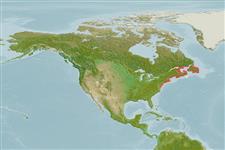Environment: milieu / climate zone / depth range / distribution range
Ecology
Marine; freshwater; brackish; benthopelagic; depth range 0 - 3 m (Ref. 85409). Temperate; 4°C - 20°C (Ref. 2059); 51°N - 35°N
Western Atlantic: Gulf of St. Lawrence in Canada to North Carolina, USA. Mainly a near-shore marine species, but far inland populations occur in lakes in Nova Scotia in Canada and in Hudson, Delaware and Susquehanna River drainages (Ref. 5723).
Size / Weight / Age
Maturity: Lm ? range ? - ? cm
Max length : 6.4 cm TL male/unsexed; (Ref. 5723); common length : 4.1 cm TL male/unsexed; (Ref. 12193); max. reported age: 3.00 years (Ref. 12193)
Adults occur mainly along weedy bays and backwaters, entering brackish water and to a limited extent, fresh water (Ref. 3814). Feed along the bottom, primarily on diatoms, worms and crustaceans by sucking in the prey with a pipetting action (Ref. 27549). Males build, guard and aerate the nest where the eggs are deposited (Ref. 205).
Life cycle and mating behavior
Maturity | Reproduction | Spawning | Eggs | Fecundity | Larvae
The male builds, guards and aerates the nest (Ref. 205).
Robins, C.R., R.M. Bailey, C.E. Bond, J.R. Brooker, E.A. Lachner, R.N. Lea and W.B. Scott, 1991. Common and scientific names of fishes from the United States and Canada. Am. Fish. Soc. Spec. Publ. (20):183 p. (Ref. 3814)
IUCN Red List Status (Ref. 130435: Version 2024-2)
Threat to humans
Harmless
Human uses
Fisheries: commercial; aquarium: public aquariums
Tools
Special reports
Download XML
Internet sources
Estimates based on models
Preferred temperature (Ref.
123201): 4.2 - 12.7, mean 6.4 °C (based on 228 cells).
Phylogenetic diversity index (Ref.
82804): PD
50 = 1.0000 [Uniqueness, from 0.5 = low to 2.0 = high].
Bayesian length-weight: a=0.01047 (0.00408 - 0.02689), b=3.07 (2.85 - 3.29), in cm total length, based on LWR estimates for this (Sub)family-body shape (Ref.
93245).
Trophic level (Ref.
69278): 3.2 ±0.38 se; based on food items.
Generation time: 1.3 ( na - na) years. Estimated as median ln(3)/K based on 2
growth studies.
Resilience (Ref.
120179): High, minimum population doubling time less than 15 months (K=0.84; tmax=3).
Fishing Vulnerability (Ref.
59153): Low vulnerability (16 of 100).
